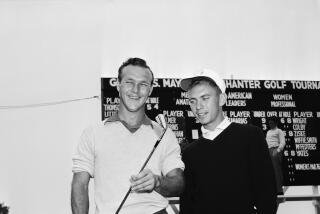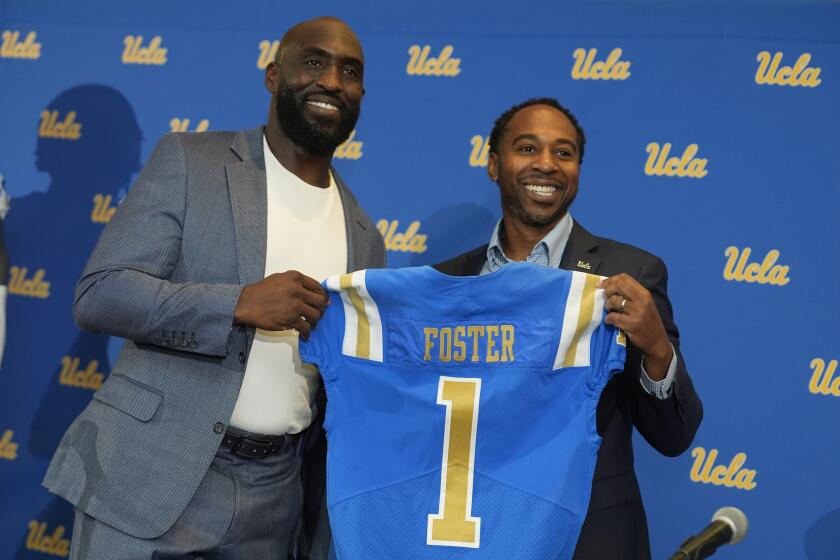Earl Woods, 74; Retired Soldier Was Golfer Tiger Woods’ Father, First Coach and Booster
Earl D. Woods, who was role model, career architect, cheerleader and first golf coach for his youngest son, Tiger Woods, died early Wednesday at his home in Cypress after a long battle with cancer, his son said. He was 74.
“My dad was my best friend and greatest role model,” Tiger Woods said in a statement on his website. “He was an amazing dad, coach, mentor, soldier, husband and friend. I wouldn’t be where I am today without him.”
Earl Woods was diagnosed with prostate cancer in 1998 and underwent radiation treatment. He told reporters in September 2004 that the cancer had returned and spread throughout his body.
He later revealed to close friends that the cancer had affected his brain and spine.
Woods had suffered a heart attack 10 years ago and had undergone quadruple bypass surgery but recovered despite complications.
Tiger Woods skipped this week’s PGA Tour event in Charlotte, N.C., to spend time with his father.
Earl Woods was president of ETW Corp., which handles his son’s business dealings, and chairman of the Tiger Woods Foundation, which in February opened the Tiger Woods Learning Center, a $25-million project in Anaheim for underprivileged youth. But Earl Woods earned his reputation for his overriding influence on the development of his golfer son.
Greg McLaughlin, executive director of the Tiger Woods Foundation and president of the Tiger Woods Learning Center, said he met Earl Woods in 1991 and realized quickly that the father had high goals for his son.
“Earl was the driving force in the development of the foundation and certainly has to be credited with that,” McLaughlin said. “But Earl was always such a visionary. I knew that as soon as I met him.
“He would say things about his son and his accomplishments ... that I thought were very aggressive. I thought he was just being a proud father. But, ironically, most of what he said came true, like Tiger being a dominant talent and threatening [Jack] Nicklaus’ records. But at first, I thought, ‘This guy is really out there.’ It amazes me now how much has come true.”
Tiger Woods, the top-ranked player in the world, has won 48 PGA Tour events since turning pro in 1996 at 20. He has won 10 major championships and, at Earl Woods’ urging, hopes to challenge Nicklaus’ record of 18.
Nicklaus told the Associated Press on Wednesday that he had “admired and related to the close bond” between Tiger and Earl.
In the forward to Earl Woods’ book “Training a Tiger: A Father’s Guide to Raising a Winner in Both Golf and Life,” written with Pete McDaniel, Tiger Woods recalled an early fascination with golf because Earl was so enthusiastic about it.
“In retrospect, golf for me was an apparent attempt to emulate the person I looked up to more than anyone: my father,” Tiger wrote.
“He was instrumental in helping me develop the drive to achieve, but his role -- as well as my mother’s -- was one of support and guidance, not interference.”
As a toddler, Tiger carried a sawed-off putter around the Woods home in Cypress. Earl Woods said later that he knew before Tiger was 1 that he would be a great player.
Earl, who had taken up golf about a year before Tiger was born, was in the habit of hitting golf balls into a makeshift driving range made of carpet and a net in the garage. According to “Tiger,” by John Strege, Tiger sat in his highchair in the garage, being fed by his mother, as Earl hit shot after shot. One day, Tiger, at 9 months, climbed out of the highchair, picked up a club that Earl had cut down for him and hit the ball straight into the net.
“I was flabbergasted,” Earl said in “Tiger.” “I almost fell off my chair. It was the most frightening thing I had ever seen.”
It was clear to Earl that his son was extraordinarily gifted, and he vowed to ensure that Tiger maximized his potential.
Earl took the 18-month-old Tiger to the driving range for the first time at the Navy courses in Los Alamitos and let him play a hole on the Destroyer Course. The toddler made an 11 on the 410-yard par-four -- eight shots to the green and three putts.
Earl recognized an opportunity to coach his son and hone his instinctive skills.
“Tiger is the first black intuitive golfer ever raised in the United States,” Earl Woods said about the time Tiger turned pro, after he had won his third consecutive U.S. Amateur championship.
Earl Dennison Woods was born March 5, 1932, in Manhattan, Kan., the youngest of six children of Maude and Miles Woods. His father was a baseball fan, and Earl, as a young man, idolized Brooklyn Dodger catcher Roy Campanella.
He enrolled at Kansas State University and played on the baseball team as a catcher, becoming the first African American baseball player in the then-Big Eight conference. He graduated in 1953 with a bachelor’s degree in sociology and a minor in psychology.
Woods married the former Kultida Punsawad in 1969 in Brooklyn, N.Y. They had met when Woods, a lieutenant colonel, was on his second tour of duty with a U.S. Army Special Forces unit during the Vietnam War.
Woods, a former Green Beret, also had become friendly with Nguyen T. Phong, a lieutenant colonel in the South Vietnamese army who had fought alongside Woods with such bravery that Woods nicknamed him “Tiger.”
Woods never forgot his compatriot and decided to name his next son Tiger, after his friend.
Woods, who had divorced his first wife before he was dispatched to Bangkok, already had two sons and a daughter before Eldrick “Tiger” Woods was born on Dec. 30, 1975. Earl Woods settled his new family in a two-bedroom tract house on a corner lot in Cypress, where he worked as a contracts administrator for McDonnell Douglas.
The family was rich in ethnicity. Earl was half African American, a quarter American Indian and a quarter Chinese. Kultida is half Thai, a quarter Chinese and a quarter Caucasian. Tiger would later label himself “Cablinasian.”
At Augusta National, when Tiger Woods won the 1997 Masters -- the first of his four Masters titles -- the first person he hugged as he left the 18th green was his father. Together, they cried. Until Earl’s health kept him from his son’s tournaments, he was a regular, waiting outside the scorer’s tent for his next hug.
Although he remained steadfast in his praise and predictions of greatness for Tiger, there were moments of controversy. Earl was once quoted as saying that Tiger would have more impact on the world than Gandhi. He denied having said it.
Derogatory comments about Scotland were also attributed to him, but Earl said he had only been “shooting the breeze” while drinking beer with some friends after a round of golf at Los Alamitos.
Earl Woods, who also wrote “Playing Through: Straight Talk on Hard Work, Big Dreams and Adventures with Tiger,” with Fred Mitchell, relished his role as a teacher.
“The bottom line is that I love to teach, to give of myself, to share the knowledge and experiences that I have ... because I believe I can communicate the lessons I’ve learned. And it is heartwarming to see the lightbulb go on.... It is a light I’ve seen many times with my own son.”
Woods is survived by Tiger, of Windermere, Fla.; wife Kultida of Tustin, and three children from a previous marriage, sons Earl Jr., of Phoenix, and Kevin, of Los Angeles, and a daughter, Royce, of San Jose.
Plans for funeral services were not announced. The family has asked that instead of flowers donations be sent to the Earl Woods Scholarship Fund, c/o Tiger Woods Learning Center, One Tiger Woods Way, Anaheim, CA, 92801.
More to Read
Go beyond the scoreboard
Get the latest on L.A.'s teams in the daily Sports Report newsletter.
You may occasionally receive promotional content from the Los Angeles Times.










